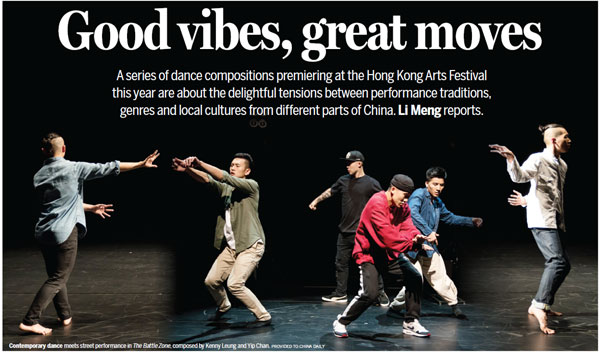
Good vibes, great moves
A series of dance compositions premiering at the Hong Kong Arts Festival this year are about the delightful tensions between performance traditions, genres and local cultures from different parts of China. Li Meng reports.
Since 2012, the Hong Kong Arts Festival (HKAF) has given local choreographers a platform to display their work in contemporary dancing. This year too, HKAF, which opened last weekend, has lined up a series of fresh dance compositions by the local creative talents, on the theme of “cross-border inspiration”.
Nearly 20 choreographers from Hong Kong and the Chinese mainland present a total of 12 pieces in three shows during the festival. Quite a few of these are hugely experimental, taking inspiration from music and theater.
The Battle Zone / Vortex show was the first to go on stage. The Battle Zone is a collaboration between contemporary dancer Kenny Leung and street dancer Yip Chan. Leung and Chan met at an overseas exchange program around a year ago and have stayed friends since then. After doing a few projects together, they decided to co-create a piece based on the interface between street dance and contemporary dance.
Since street dance is often inspired by the idea of a face-off between two or more groups, the choreographers thought of designing a scene in which street dancers will compete with practitioners of contemporary dance. Narration and theatrical elements were incorporated to challenge set ideas about the two distinct dance genres. Although designed to look like a competition, the choreographers say the piece was meant to explore possibilities of starting a dialogue between the two genres.
“The ‘battle’ is not merely between the two dancing styles,” Leung said. “It is also about how we dancers battle with ourselves.”
Trained in the field of Chinese dance at the Hong Kong Academy for Performing Arts, Leung went to Taipei National University of the Arts three years ago to pursue a Masters degree in contemporary dance. He expects to explore various styles in the dance world, remove unnecessary barriers between genres and combine different elements to inspire his own performance as well as the productions he designs.
His training in Chinese classical dance forms has given him a sense of fluidity and rhythm that informs his own compositions of contemporary dance works, said Leung. “And discussing my ideas with friends from other dance fields, such as Yip, helps sharpen my understanding of diverse dance languages.”
Vortex is the creation of local dancer and choreographer Wayson Poon. He grew up in Hong Kong, worked in a Beijing dance studio for quite a few years in between before coming back to the city in 2014 to become an independent dancer.
Poon draws inspiration from his frequent travels and exposure to different cultures as a result. Vortex, a half-hour duet, was inspired by one of Poon’s trips to London three years ago.
“I was walking along the riverside with my boyfriend in London, when four white men appeared. Seeing us holding hands, they started calling us names,” Wayson recalled. “Even in a multi-cultural metropolis like London, some people are still against homosexuality and racial equality.”
The incident made him want to examine the idea of “connection”, between individuals, cultures and value systems.
Vortex begins with two male performers dancing on their own, in opposite corners of the stage, who then advance toward each other, attempting to respond to each other’s moves. The body language is quite abstract but viewers do not have to try too hard to make sense of what’s going on. “I care a lot about how individuals deal with the relationships they have with fellow members of the community,” said Poon.
He said the work will neither “deliver clear messages” nor “point out clear directions”. The audience may have diverse feelings and emotions after watching the piece, which, he believes, are authentic reflections of the different life experiences they might have. The connection forged between the dancers and the audience is the most important thing, said Poon.
Vortex is also highly informed by literary ideas. Poon and his dancing partner are voracious readers. Sometimes they would pull out a random book from a pile, find a word or a sentence in it and then try to express the idea through movements.
“These performances are very random and unplanned, but they always seem to have unexpected powers, magically leading us to the places we wanted to go,” said Poon.
The Belgian composer and sound artist Peter Lenaerts was invited to set The Battle Zone / Vortex to music. Lenaerts also had discussions with the choreographers about the potential for meetings between dance and music as well as possible areas where trying to combine the two might make for an unhappy marriage.
More in March
The two forthcoming shows in March, Dance Exchange and Dance Off, too are about bringing different elements together. Four local choreographers, together with their counterparts from the mainland, have created the three pieces in Dance Exchange. Basically, the show is about sharing stories from distinct regional cultures of China and how these affect contemporary dance.
Dance Off comprises a piece each by seven local artistes. Felix Ke, inspired by the American writer Don DeLillo’s award-winning novel White Noise, examines the individual’s fear of death on stage. Tracy Wong and Rex Cheng have worked with performers from other creative fields to develop their pieces. Wong’s piece explores the anxiety experienced by ordinary people caught up in the hustle and bustle of the city. Rex Cheng, trained in the classical Chinese tradition, uses movements borrowed from Chinese operas in his dance duet composition, trying to bridge the modern and traditional styles.
“No matter which genres we work in, the most significant thing is to be able to express ourselves in an authentic and open-minded way,” said Leung, underscoring the importance of fine-tuning one’s own art even as one looks to develop such crossover projects.
